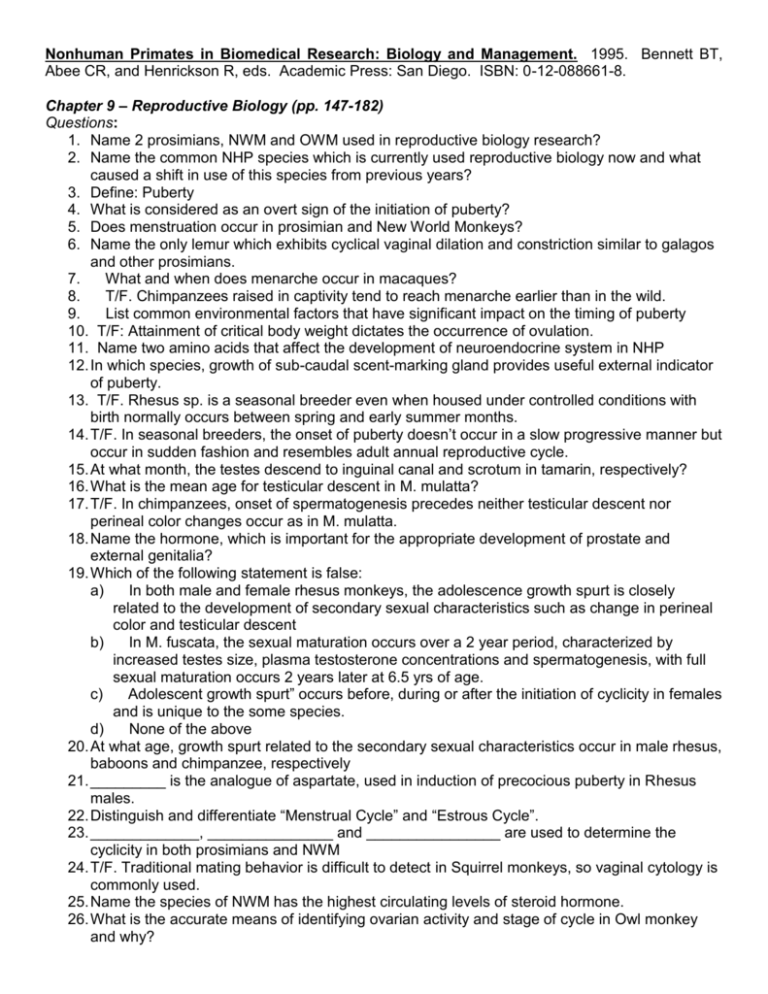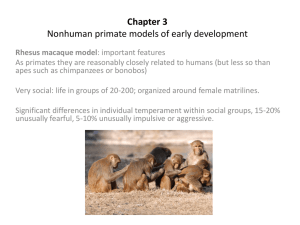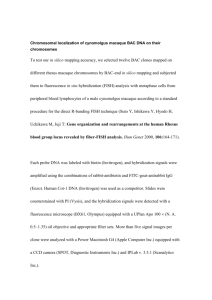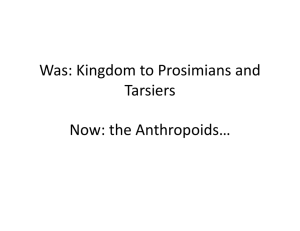Chapter 9
advertisement

Nonhuman Primates in Biomedical Research: Biology and Management. 1995. Bennett BT, Abee CR, and Henrickson R, eds. Academic Press: San Diego. ISBN: 0-12-088661-8. Chapter 9 – Reproductive Biology (pp. 147-182) Questions: 1. Name 2 prosimians, NWM and OWM used in reproductive biology research? 2. Name the common NHP species which is currently used reproductive biology now and what caused a shift in use of this species from previous years? 3. Define: Puberty 4. What is considered as an overt sign of the initiation of puberty? 5. Does menstruation occur in prosimian and New World Monkeys? 6. Name the only lemur which exhibits cyclical vaginal dilation and constriction similar to galagos and other prosimians. 7. What and when does menarche occur in macaques? 8. T/F. Chimpanzees raised in captivity tend to reach menarche earlier than in the wild. 9. List common environmental factors that have significant impact on the timing of puberty 10. T/F: Attainment of critical body weight dictates the occurrence of ovulation. 11. Name two amino acids that affect the development of neuroendocrine system in NHP 12. In which species, growth of sub-caudal scent-marking gland provides useful external indicator of puberty. 13. T/F. Rhesus sp. is a seasonal breeder even when housed under controlled conditions with birth normally occurs between spring and early summer months. 14. T/F. In seasonal breeders, the onset of puberty doesn’t occur in a slow progressive manner but occur in sudden fashion and resembles adult annual reproductive cycle. 15. At what month, the testes descend to inguinal canal and scrotum in tamarin, respectively? 16. What is the mean age for testicular descent in M. mulatta? 17. T/F. In chimpanzees, onset of spermatogenesis precedes neither testicular descent nor perineal color changes occur as in M. mulatta. 18. Name the hormone, which is important for the appropriate development of prostate and external genitalia? 19. Which of the following statement is false: a) In both male and female rhesus monkeys, the adolescence growth spurt is closely related to the development of secondary sexual characteristics such as change in perineal color and testicular descent b) In M. fuscata, the sexual maturation occurs over a 2 year period, characterized by increased testes size, plasma testosterone concentrations and spermatogenesis, with full sexual maturation occurs 2 years later at 6.5 yrs of age. c) Adolescent growth spurt” occurs before, during or after the initiation of cyclicity in females and is unique to the some species. d) None of the above 20. At what age, growth spurt related to the secondary sexual characteristics occur in male rhesus, baboons and chimpanzee, respectively 21. _________ is the analogue of aspartate, used in induction of precocious puberty in Rhesus males. 22. Distinguish and differentiate “Menstrual Cycle” and “Estrous Cycle”. 23. _____________, _______________ and ________________ are used to determine the cyclicity in both prosimians and NWM 24. T/F. Traditional mating behavior is difficult to detect in Squirrel monkeys, so vaginal cytology is commonly used. 25. Name the species of NWM has the highest circulating levels of steroid hormone. 26. What is the accurate means of identifying ovarian activity and stage of cycle in Owl monkey and why? 27. Name an NWM that shows regular estrous cycle with obvious skin changes. 28. Name the species in which Oogenesis continues to occur into adult life 29. The gestation period of Callithrix (tamarin) is 140-150 days with no post-partum estrus? 30. T/F. The estrous cycle of common marmoset is 28.6+1.0 days 31. T/F. Seasonality doesn’t occur in marmosets or tamarins. 32. Which is true regarding the reproductive biology of Squirrel monkeys a) Squirrel monkeys are seasonal breeders and have a narrow time for conception b) Occurrence of behavioral estrus is also seasonal and is independent of physical contact with males c) Adaptation to captivity is important in this species, up to 3 breeding seasons for female d) Squirrel monkeys become heavier during breeding seasons (March to May in Northern hemisphere) associated with increased testes size, spermatogenesis and increased plasma testosterone concentrations, with less less evident in females. e) All of the above 33. T/F. Rhesus is a seasonal breeder (lab reared or wild) but long-tailed macaques is unaffected by the season. 34. ___________ is the most accurate method for detecting ovarian activity and stage of the cycle in Rhesus sp? 35. ________ cells in the ovary, is the primary source of estradiol. 36. The follicular phase and luteal phase are characterized by increased concentrations of _________ and ________ hormone; and the length luteal phase is usually remaining constant. 37. What is the functional of life span of CL in regular cycling Rhesus 38. What is the unique characteristics of mouse lemur trophoblast compared to other members of Lorisidae 39. What is the type of placentation in prosimians 40. Name the prosimians which falls into the “litter-bearing” category with 75% of the birth results in twins and triplets 41. Describe the type of placenta for OWM and apes 42. When is the maximum fetal weight gain attained during gestation 43. At what day of gestation, implantation bleeding “placental sign” occurs in M. mulattta and M. fasicularis 44. From where and how, estriol is secreted during the human pregnancy. Which OWM shares this feature? 45. What is the average length of gestation in Rhesus and M. fascicularis? 46. T/F. Ovariectomy can be performed in macaque during pregnancy without risking abortion, provided if its performed after LPS (Luteal Placental Shift) 47. What is Luteal-Placental Shift? 48. What is RU 486a? 49. Which hormone is the regulators of contractile motility and serves as a critical component in the onset and progression of labor? 50. What is the role of relaxin in primate pregnancy? 51. What is the color of colostrums in Squirrel monkey, baboons and chimpanzees? 52. What are the common causes for post-partum amenorrhea? 53. T/F. Primiparous females appear to have longer inter-birth intervals than multiparous females. 54. What are the major characteristics or features associated with reproductive senescence in nonhuman primate females? 55. Which is the longest-lived prosimian? 56. What is the characteristics post-menopausal appearance in rhesus macaques? 57. Describe the hormonal profile indicative of secondary amenorrhea in Rhesus? 58. T/F. Studies in different species of Macaque and Chimpanzee suggest that the regular occurrence of menopause may be limited to human female. 59. T/F. There is a direct correlation between decreased reproductive potential and the circulating testosterone. 60. Which species could serve as a model to study impotence related to vascular changes in male? 61. What are the common morphological changes in penis associated with aging in male baboons? 62. Which hormone plays a central role in control of spermatogenesis in primates? 63. What are the basic morphologic components of spermatozoa in NHP? 64. What are the components of seminiferous epithelium? 65. Which is the major androgen produced by humans and macques compared with Squirrel monkey? 66. Describe the “Fatted Male Response” in squirrel monkeys 67. T/F. Marmosets show a diurnal pattern in testicular steriodogenesis characterized by decreased testosterone level in daylight 68. What are the unique characteristics of Owl monkey spermatogenesis? 69. Describe the morphology of spermatozoa in Macaques and Baboons 70. Define: Capacitation 71. What is the primary function of epidydymis? 72. Which hormone determines the number of germ cells in primate testis? 73. Name an NHP whose sex skin is unaffected by castration and what is the color? 74. Name few macaques that are seasonal breeders and that breed all year around. 75. Which species has a seasonal breeding period in the Northern Hemisphere a. Chimpanzee b. Cynomolgus monkey ! c. Rhesus d. Baboon 76. What is the birthing season for captive rhesus monkeys in the Northern Hemisphere? 77. When does ovulation occur in baboons? a. 1-2 days prior to deturgescence b. The day of deturgescence c. 1-2 days after deturgescence 78. What is the gestation period of baboons 79. What is the gestational period of chimpanzees? 80. T/F. Photoperiod and temperature variation do not appear to be important factors in maintenance of reproductive seasonality in lab-reared females, suggesting that it is mediated via hypothalamus. Answers: 1. Lemurs and Bushbabies (prosimians); Squirrel Monkeys, marmosets and tamarins (NWM); Rhesus, Cynomologus, AGM, pig tailed macaques, baboons (OWM) and apes. 2. Cynomologus sp. Ban on importation of rhesus by the Indian Continent and ready availability of long-tailed macaque from Indonesia and the Philippines Islands 3. It encompasses the period of development from which the first changes in reproductive hormones are evident and the capacity of individual to reproduce successfully is achieved. 4. Menarche- - Onset of Menstrual activity 5. No, true estrous cycle for these species 6. Ruffed Lemur 7. Menarche – Onset of menstruation occurs approximately at 2 yrs. 8. True 9. Stress, dietary changes, photoperiod, environmental cues 10. True 11. Tryptophan and Tyrosine 12. Aotus spp. The structure is not present in juvenile male, but occurs at 282-370 days. 13. True 14. True 15. 2-3 months – inguinal canal and within scrotum by 8-11 months. 16. 3.3 + 0.7 yrs, 17. True 18. DHT 19. d 20. 2.5 yrs, 3-4 yrs, and 9.5 yrs (11 peak) 21. N-methyl-D-aspartate 22. Ovarian cyclicity refers to follicular growth and formation of CL; whereas menstrual cycle refers to period of time between the on set of vaginal hemorrhage from cycle to the next. Unlike estrus, which occurs at the maximum follicular growth and estrogen production, menses occur when there is little hormone production 23. Vaginal dilatation or constriction of vaginal orifice, vaginal smear and serum hormonal profile 24. True 25. Squirrel monkey 26. They don’t show cyclical changes in either swelling or coloration of external genitalia, and vaginal cornification (cytology) is of limited value. So the measurements of serum and urine steroid hormones are required to determine the ovarian activity in this species. 27. Howler monkey 28. Slow loris 29. True 30. True 31. True 32. All of the above 33. True 34. Serum/Urine Hormonal profiles 35. Granulosa cells 36. estrogen, progesterone 37. 14 days 38. The trophoblast invade the stroma, with greater part of uterine and trophoblastic relation is epitheliochorial 39. Epitheliochorial 40. Ruffed lemur 41. 23 days and 18-21 days 42. Hemochorial, Bidiscoid placenta 43. 145 days 44. Placenta due to the presence of 16-alpha-hydroxylase within fetus, Great apes shares this feature whereas macaques do not. 45. 165-170days and 155-165 days 46. True 47. The change in production of hormones from ovary to placenta. Usually it takes place approximately at the 3rd week of pregnancy. It emphasizes that placenta is responsible for hormonal support in maintenance of pregnancy for the remainder of pregnancy in conjunction with interaction of embryo/fetus 48. Synthetic progesterone receptor antagonist 49. Prostaglandin 50. Promote myometrial relaxation and helps uterine quiescence by inhibiting oxytocin release, enhances cervical ripening, and stimulate separation of pubic symphysis 51. Squirrel monkey: Orange-tinged; Baboons: thin, opalescent liquid and Chimpanzees: whitish, opalescent, and stringy secretion. 52. Lactation, proximity of infants and reduced sexual activity 53. True 54. Progressive decline in vaginal bleeding, change in circulating patterns of steroid and gonadtrophic hormones, decline in reproductive efficiencies i.e fewer conceptions and more still births 55. Lemurs (30-40yrs) 56. Facial pigmentation and gray/thinning of hair 57. Is due to hypothalamic dysfunction, characterized by low estradiol, and progesterone in conjunction with FSH and LH which never increase above the midcyle levels. 58. True 59. False 60. Baboons 61. Penile angiopathy with lumen stenosis, fibrous trabeculopathy and interatrabecular senachiae. 62. FSH (LH in most other mammalian species) 63. The head (chormain, capped with acrosome), neck (basal plate containing pieces and centriole, midpiece (mitochondria) and tail. 64. Seminiferous tubules and Sertoli cells. 65. Androstenedione, DHEA in squirrel monkey 66. Its exhibited by squirrel monkey, characteristic weight gain 200-300g beginning at 2-3 months before mating activity 67. True 68. Partial arrest of spermatogenesis occurs throughout the year. Electroejaculation is characterized by low sperm numbers, some degenerated spermatocytes and orange brown pigment in intertubule tissues, but fertility is maintained. 69. Macaques: Flat, spaddle shaped head with long mid piece in relation to head and the mitochondria of the midpiece is small and well organized Baboon: Short, paddle shaped head with anterior tapering. The anterior segment of acrosome is surrounded by marginal thickening and covers roughly one-third of the head. The mid piece is long and regular sheath of mitochondria. 70. Phenomenon affecting the sperm capable of fertilization. It normally occurs in female reproductive tract and it requires approximately 2-8 hr 71. Maturation and storage of spermatozoa 72. FSH 73. Cercopithecus/Miopithecus talapoin (small AGM), Blue. The blue coloration is attributed to the melanin-like pigment in the dermis; and appears to be unrelated to testosterone. 74. Seasonal breeders: M. fuscata, M. mulatta and M. sylvana Year Around: M. arctoides, M. fascicularis, M. radiate, Papio cynocephalus and Great apes. 75. c, rhesus 76. March-June 77. a, 1-2 days prior to deturgescence 78. 164-186 days 79. 227-235 days 80. True








